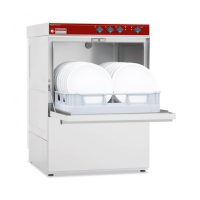INSTRUCTION MANUAL FOR DISHWASHERS
Page 7 of 10
• Select the washing cycle suited to the type of dishes using PROGRAMME SELECTION (3)
the button pressed, the shorter cycle is enabled (Fig. 4).
• Press START (3) for automatic start (Fig. 6).
• Lower the hood, the cycle starts automatically and the CYCLE UNDERWAY (5) led starts to flash.
• When the cycle is completed the CYCLE UNDERWAY (5) led goes off.
• The next cycles come on simply by lowering the hood.
• For rapid drying, remove the rack from the machine as soon as the cycle finishes.
•
To stop a wash cycle early, press START (3).
4.5 Removing the integral filter
• Move the washing and rinsing arms at right angles to the edge of the door (Fig.7).
• Lift each semi-filter by the relative handle.
4.6 Emptying the dishwasher
4.6.1 Appliances with no drain pump
• Switch the dishwasher off.
• If present, remove the integral filter (Fig.7 A).
• Pull up and remove the overflow pipe (Fig. 8 B).
• Wait for the tub to empty completely.
• If necessary, extract the tub filter and clean (Fig. 8 C).
4.6.2 Appliances with drain cycle (*optional)
• Switch the dishwasher off.
• If present, remove the integral filter (Fig.7 A).
• Pull up and remove the overflow pipe (Fig. 9).
• Close the door.
• Press the DRAIN (2) button for a few seconds to start the cycle;
• In the versions without a drain button, press START (4) for a few seconds to start the drain cycle.
• The drain cycle is shown by the POWER (5) led coming on and the CYCLE UNDERWAY (5)
flashing.
• The machine runs a drain cycle and then switches off.
• If necessary, extract the tub filter and clean (Fig. 8 C).
4.7
Resin regeneration (*optional)
In machines with internal water softener, a regeneration cycle should be ru
n periodically to ensure the
correct operation of the softener. The number of cycles between one resin regeneration and the next
depends on the hardness of the local water, and should be set in accordance with the following table.
dH °F
dH °F
7 12 150
14 25 80

